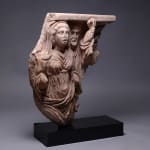Relief from a Mythological Sarcophagus, 200 CE - 220 CE
Marble
height 59 cm
height 23 1/4 in
height 23 1/4 in
AM.0427
Further images
This attractive relief was part of a large marble sarcophagus, designed to commemorate an important Roman individual. The original composition depicted an entire assembly of figures in high relief. Two...
This attractive relief was part of a large marble sarcophagus, designed to commemorate an important Roman individual. The original composition depicted an entire assembly of figures in high relief. Two women are preserved on this segment: standing in the foreground is a young woman, facing the viewer, and behind her a much older companion who looks on.
Clearly the focus of the composition, the young woman has an expressive face with rounded cheeks and piercing eyes. She is dressed in a chiton belted below the breasts and has a himation draped over her shoulders and head. Her hair is neatly combed in a scalloped arrangement, following the fashion popularized by the Empress Julia Domna during the early third century AD. The coiffure confirms that this is a portrait of a lady who lived sometime during the Severan dynasty.
At that time the practice of cutting portrait heads on figures on sarcophagi reliefs was a favourite conceit of the Roman world. The wealthy individuals who were able to commission such sarcophagi often selected famous mythological episodes as the subject for their monument and had the story personalised by carving the head of the protagonist to resemble their own likeness. The deceased was therefore glorified by appearing in a mythic context, taking on the guise of a famous hero or heroine and acting out the expected role within the prescribed narrative.
On this piece the young woman has chosen to be shown as a heroine of Greek myth. She is accompanied by an elderly servant woman whose exaggerated features indicate a very advanced age. The servant woman is a stock figure who appears on many mythological sarcophagi, particularly those depicting Phaedra’s story of forbidden love or the tragic tale of the enchantress Medea. Although it is difficult to discern which of these myths is shown on this beautiful relief, the piece successfully captures the pathos of Greek tragedy and transports us into a world where myth and reality loose all distinction, and where real people present themselves as actors in famous legends from the past.
For mythological sarcophagi in general see, C. Robert, ‘Die antiken Sarkophag-Reliefs,’ vol. 3.2. (Rome, 1969).
Clearly the focus of the composition, the young woman has an expressive face with rounded cheeks and piercing eyes. She is dressed in a chiton belted below the breasts and has a himation draped over her shoulders and head. Her hair is neatly combed in a scalloped arrangement, following the fashion popularized by the Empress Julia Domna during the early third century AD. The coiffure confirms that this is a portrait of a lady who lived sometime during the Severan dynasty.
At that time the practice of cutting portrait heads on figures on sarcophagi reliefs was a favourite conceit of the Roman world. The wealthy individuals who were able to commission such sarcophagi often selected famous mythological episodes as the subject for their monument and had the story personalised by carving the head of the protagonist to resemble their own likeness. The deceased was therefore glorified by appearing in a mythic context, taking on the guise of a famous hero or heroine and acting out the expected role within the prescribed narrative.
On this piece the young woman has chosen to be shown as a heroine of Greek myth. She is accompanied by an elderly servant woman whose exaggerated features indicate a very advanced age. The servant woman is a stock figure who appears on many mythological sarcophagi, particularly those depicting Phaedra’s story of forbidden love or the tragic tale of the enchantress Medea. Although it is difficult to discern which of these myths is shown on this beautiful relief, the piece successfully captures the pathos of Greek tragedy and transports us into a world where myth and reality loose all distinction, and where real people present themselves as actors in famous legends from the past.
For mythological sarcophagi in general see, C. Robert, ‘Die antiken Sarkophag-Reliefs,’ vol. 3.2. (Rome, 1969).





